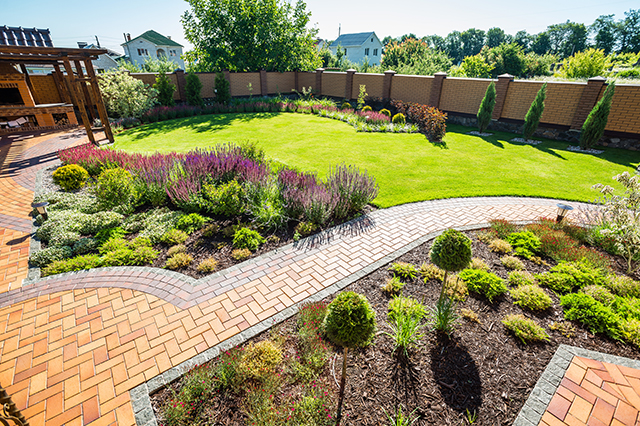Everyone wants the perfect lawn landscape, but not everyone knows how to get there. While maintaining freshly trimmed, healthy grass is essential, the right landscaping and gardening techniques will make your yard the talk of the neighborhood. Whether you’re starting to give your lawn a new look or just want a refresher, these techniques will help to make your yard look clean, attractive and welcoming.
Lawn Maintenance Basics
It’s important to not cut your lawn too short, as this can actually provide an opportunity for weeds to grow. Instead, keep your grass at a healthy, manageable length. In addition, watering less frequently encourages grass growth over weed growth.
You can pull most annual weeds out by hand, but perennials with deep and tough root systems might necessitate a tool to dig them out. Finally, be sure to apply just the right amount of fertilizer to the soil, typically in the spring and fall. These nutrients will enable the grass to grow up healthy and strong, but make sure not to apply too much!
Create a Rough Sketch of Your Lawn
Before you start working on your lawn landscape, one of the most important things to do is create a rough sketch of how you want it to look. Try to keep the drawing to scale so you can have an early idea of how the different elements of your lawn and garden will work together. With this handy blueprint, you can foresee any potential issues before you start on your project.
Planning Your Lawn Landscape
Before you plant anything new, take care of all your hardscaping, which means anything like a walkway, patio, fencing or other additions you want to add. You’ll likely have to do some digging, and you want everything made of stone or wood set in place before you start gardening.
To make sure your garden looks good all year round, choose a variety of plants that will bloom at different times and lay out your yard accordingly. Be sure to research how fast your plants grow and you’ll be able to plan your lawn maintenance better. If one plant or tree grows too quickly or too big and overshadows others, you’ll want to prune it accordingly.
Designing Your Lawn Landscape
As long as you have space, it’s usually a good idea to border your yard with wide flower beds, which will make the lawn look more luxurious than a few patches of flowers here and there. The border between grass and flower bed doesn’t need to be the same across the entire lawn, as this can look stiff and tiresome. Instead, use an intuitive approach to decide how the fluid shape of your flower bed will look depending on the surrounding elements.
One essential element of any lawn landscape is having focal points that limit the monotony and help your garden look interesting and well-composed. These can be anything from a small unique ornamental tree, to a well-positioned statue or arch. But don’t overdo it! Having a whole array of gnomes, animal sculptures, sundials and other ornaments can distract from the other elements of your yard.

Adding Color to Your Lawn
Color is another area where you want to be very careful. Some gardeners choose a random mix of flowers to plant in their garden, but this doesn’t always play out so well. Too much color without a sense of harmony can look more chaotic than beautiful. If you’re new to gardening, keep it simple at first and try to go mostly with shades of one color. Think of yourself as an artist who’s restricting themselves to a certain palette or color scheme. For instance, having a few patches of pink, red and white tulips can look elegant and pleasing, but adding orange tiger lilies to the mix might not work.
Adding a Shade Garden to Your Lawn Landscape
Grass won’t grow under trees, so be sure to plan your lawn landscape accordingly. Instead of leaving patches of dirt under that big maple, you can create a walking path, or arrange large rocks to make the area look more interesting. Creating a shade garden underneath your large trees is another great choice. Seed some plants that require little sunlight, and watch them thrive around your trees. Your best choices for a shade garden are shallow-rooted plants that won’t compete with the tree’s roots, such as sedum and plantain lilies.
The options are endless for creating a great lawn landscape, but these basics can get you off on the right foot and make your yard a little more structured and harmonious.
Have any great lawn maintenance or design tips to share? Share them with us in the comments!
3 Thoughts on “Get the Perfect Lawn Landscape”
Leave A Comment
Comments are subject to moderation and may or may not be published at the editor’s discretion. Only comments that are relevant to the article and add value to the Your AAA community will be considered. Comments may be edited for clarity and length.


















Rather than going for the perfect lawn and the expense of the upkeep, consider the potential for a natural landscape of local plants and flowers with a pollinator garden. Once established, they require little to no effort. Decorative features such as walks, benches, fountains can still be used to make your area more distinctive. Reach out to local horticulture groups and there is amazing information on the internet. Let’s stop living by chemicals and reinvigorate our living space.
How about an article about lawn ALTERNATIVES??? Save water, go with native plants and be more environmentally friendly, less fertilizer leaching into ground water, etc.
Loved the lawn article, now I need to find someone to help me, but now I have a sense of planning. Thanks !!!!